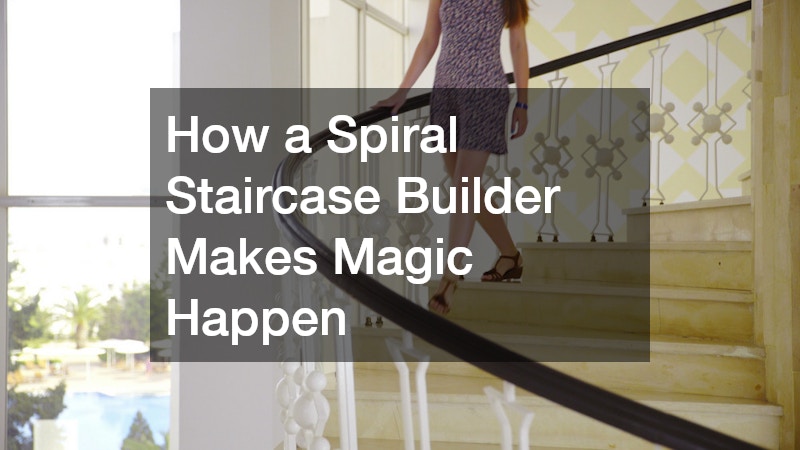There’s something undeniably captivating about a spiral staircase. Whether it’s a sleek, modern metal design winding through an industrial loft or a grand wooden spiral rising through a historic home, these staircases blend practicality and poetry in a way few architectural features can. Behind every elegant curve and precise angle lies the work of a skilled spiral staircase builder—part engineer, part artist, and part magician. Crafting these architectural marvels demands not only technical expertise but also an eye for design and a deep understanding of materials, space, and human movement. A spiral staircase builder doesn’t just construct stairs—they create a sculptural centerpiece that transforms the atmosphere of a space.
What Materials are Commonly Used in Building a Spiral Staircase?
An overview of popular materials
The magic of a spiral staircase often begins with the selection of materials. Each type—wood, metal, or composite—brings its own character and performance qualities, influencing both the aesthetic and structural aspects of the final design.
Wood remains one of the most beloved materials for spiral staircases, prized for its warmth, versatility, and timeless beauty. Woods like oak, walnut, maple, and cherry are frequently used, offering rich grain patterns and a tactile sense of craftsmanship. Wooden staircases often complement traditional or rustic interiors, though modern builders may pair wood with glass or steel for a contemporary twist. Beyond aesthetics, wood’s natural resilience allows it to absorb sound and provide a comfortable surface underfoot.
Metal, on the other hand, lends a completely different energy to a spiral staircase. Steel, wrought iron, and aluminum are common choices for builders seeking strength, durability, and precision. Metal staircases can achieve slimmer profiles than wood, creating sleek, space-efficient designs ideal for modern architecture. Powder coatings and finishes allow for a wide range of looks—from matte black industrial to polished chrome elegance. Because metal can be formed into precise shapes and curves, it enables spiral staircases with tight radii and intricate detailing that would be difficult to achieve with other materials.
Composite materials and glass have also entered the scene, particularly in contemporary and minimalist designs. Glass treads and railings add an ethereal lightness, making the staircase appear to float. Composites, which may combine resins with fibers or other reinforcements, offer builders increased flexibility, weather resistance, and strength while reducing maintenance. These materials are often chosen for outdoor or high-traffic environments, where durability and longevity are paramount.
Ultimately, the choice of material sets the tone for the entire design. A spiral staircase can feel stately and classic, industrial and bold, or futuristic and minimalist—simply depending on what it’s made from and how those materials are treated.
How Does the Design Process Ensure Safety and Stability?
The importance of design and engineering
While the allure of a spiral staircase lies in its beauty, its design must begin with safety and structural integrity. Behind every graceful curve is a rigorous engineering process that ensures the staircase can support weight, maintain balance, and comply with local building codes.
The design process starts with precise measurements of the space and a clear understanding of its purpose. Factors such as tread width, riser height, handrail placement, and central column diameter must all be meticulously calculated. A builder must balance aesthetic goals with ergonomic practicality—each step must be comfortable to walk on while maintaining a consistent rhythm that feels natural to climb.
A key structural element of most spiral staircases is the central column, which acts as the spine of the design. Every tread connects to this core, distributing weight evenly and providing stability. Engineering this component requires knowledge of load-bearing principles and materials science to prevent flexing or wobbling over time.
Safety codes also dictate aspects such as tread depth, railing height, and spacing between balusters. These standards ensure that staircases remain secure for all users, including children and the elderly. In commercial or public settings, regulations are even more stringent, requiring builders to incorporate non-slip surfaces, proper lighting, and adequate headroom clearance.
Modern spiral staircase builders often use computer-aided design (CAD) software to model their projects in 3D, allowing them to simulate loads and visualize potential problem areas before construction begins. This fusion of artistry and engineering ensures that each staircase isn’t just beautiful—but also rock-solid and safe for generations of use.
What are the Key Aesthetic Considerations in Crafting a Spiral Staircase?
Balancing function and form
A spiral staircase is as much a statement piece as it is a functional structure. Its very shape draws the eye upward, guiding movement and sightlines through a space. Because of this, aesthetic considerations play a vital role in every project.
The first design choice is style—whether the staircase should blend seamlessly into its surroundings or stand out as a dramatic focal point. In a minimalist home, a staircase with slim metal treads and a simple railing might emphasize clean lines and openness. In contrast, a sweeping wooden spiral with ornate balusters and a polished handrail can evoke classic elegance and craftsmanship.
Proportion and flow are equally important. The spiral must appear balanced and harmonious from every angle. A well-designed staircase enhances the spatial experience, making even small areas feel dynamic and expansive. Builders pay close attention to lighting as well—natural light filtering through open risers or glass elements can add a sense of movement and airiness.
Finishing touches such as handrail profiles, tread edges, and color treatments can elevate a design from functional to extraordinary. The finish might highlight the grain of the wood, reflect ambient light off metal surfaces, or add contrast through texture. Every decision contributes to the overall mood and personality of the staircase.
Building a spiral staircase is an art form where engineering precision meets creative vision. It’s a process that demands mastery over materials, an understanding of human ergonomics, and an appreciation for architectural beauty. From choosing the perfect wood or metal to designing for safety and sculpting graceful curves, a spiral staircase builder brings together countless details into one cohesive masterpiece.
The result isn’t just a means of moving between floors—it’s a work of art that transforms the space around it, inviting admiration and awe. In every twist and turn of a spiral staircase, the builder’s craftsmanship and imagination are on full display—proof that even in the most functional parts of a home or building, magic truly can happen.




